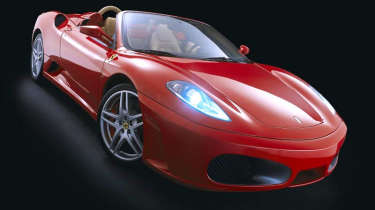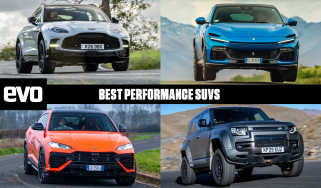F430: Along Comes A Spider
It's just five months since the launch of the F430 Berlinetta, so it was a bit of a surprise when Ferrari revealed the Spider version at the Geneva show. Just hours before the car was crated up and transported to Switzerland, evo was given the sneak preview you see here.
The Spider comes with the same hardcore specification as the metal-roofed Berlinetta, including the electronic differential developed by the F1 division and fitted on a road car for the first time when the Berlinetta was launched. The two cars also share the same 483bhp 4.3-litre V8.
The show car features optional carbon brakes, which look magnificent behind the unique spidery forged alloy wheels fitted to all F430s. Customers will be able to specify the spider's soft top in a variety of colours, including black, Bordeaux, beige and blue.
The Spider's kerb weight rises by 70kg over the Berlinetta, making it 1520kg, but performance is hardly dented, with a claimed 0-62mph time of 4.1sec being a mere 0.1sec slower. Top speed is claimed at over 193mph. Prices are yet to be announced, but expect to pay around £130,000.
While in Maranello with the F430 Spider we met up with Giuseppe Bonollo who, as director of product strategy at Ferrari, has the enviable task of looking after the future development of all Ferrari cars. So, we asked him a few questions...
evo: Why did you launch the Spider so soon after the Berlinetta?
'When you look back at the launch of the 360 Spider in late 2000 it followed almost two years after the 360 Coupe. This was because we were still working on a new roof mechanism with our partner CTS in Germany and this new electric roof mechanism took time to perfect. Once we had decided to use exactly the same system as we developed for the 360 on the F430 there was no need to look into further development time, as the electric roof mechanism was already proven.'
evo: Did you look at alternative roof mechanisms, like the folding metal set-ups used by Mercedes?
'Yes we did but it soon became clear that packaging is a real problem with this sort of roof if you have a mid-engined car. This is especially true at Ferrari because it was felt essential to keep the F430's engine exposed under the glass cover and this would have proved impossible had we gone for a folding metal roof option. This is also the reason why we have not gone for a glass rear window, preferring to stick with a PVC window instead. A glass rear screen would again have compromised packaging, leading to a reduction in the glass area over the engine.
'Another reason why we stuck with the canvas soft top is that 360 customers seemed to like it on their cars so there was no demand for a change from existing owners.'
evo: How important is the Spider version to Ferrari in terms of sales?
'If you look back at the 360 again you can see that once the Spider version was launched sales of this model were actually higher than those of the Berlinetta. If you look at 2002 (its first full year of production), for example, it actually accounted for 58 per cent of total 360 sales. This isn't reflected in total production figures for the 360, as there were nearly two years of 360 coupe sales before the Spider version reached production. (A total of 17,500 360s were produced over the five years of production. 10,000 were coupes, made up of 8500 standard coupes, 1200 Challenge Stradales and 300 race cars. The remaining 7500 were Spiders). I would predict that at least 60 per cent of future F430 sales will be Spiders, even though we already have orders for over two years' worth of production (around 6000 cars).'
evo: Why do you think Spider sales are increasing faster than Berlinetta sales?
'The feedback we get from customers is that there was very little trade-off between the dynamics of the Berlinetta and the Spider version of the 360. This is because the car was developed to be a Spider from the outset and was exceptionally stiff compared to previous generations of Ferrari Spiders thanks to the new aluminium spaceframe. With the F430 it is the same story, although the Spider is a further 10 per cent stiffer in torsion than the 360 was, as well as 5 per cent stiffer in terms of bending resistance.'
evo: To what extent has the shape of the F430 Spider been dictated by future crash regulations?
'The hard one for us to meet is the new rear crash test in the US - this has meant re-engineering the rear crush structure of the car compared to the 360. There are also additional bars in the doors, compared to the Berlinetta version, to help us meet the off-set crash regulations.'
evo: Bearing in mind the increased cross-over of technologies between Ferrari's F1 cars and road cars, have you considered developing a V10 engine for the road?
'Yes, we did look at it, but not for very long! The current V10 F1 engine is the perfect engine configuration due to the present F1 regulations. This does not mean it is a perfect solution for our road-car engines. The short-stroke V8 fitted in the F430 is perfect for Ferrari - we want this engine to have a very different character from our V12 engine, with a very high rev characteristic. This is the direction we will take with future engines and anyway, no customers have ever complained about our V8 engines, so there is little reason to change!'
evo: Moving on to the other cars in the Ferrari range, are there any new developments we can expect to see soon?
'At Geneva we will be showing a more sporting version of the 612 with the same carbon brakes as fitted to the 575M, as well as new 19in split rim wheels, both of which will become options on the 612. Mechanically it is very close to the standard car as we didn't want to compromise the ride too much. The other main change is a re-programming of the software controlling the gear change that makes the change quicker than before. These changes have been made in response to customer requests.
'After that will be the 575 replacement but I'm not prepared to say exactly when at the moment. We will continue to surprise the market with further niche models from time to time, like the Superamerica or the Enzo for example, as we would rather do these types of limited run cars than increase production of our main models in an effort to meet demand. We do not intend producing more than 5000 cars a year at Ferrari and last year was very close to this figure with 4900 cars being produced in the year to December 2004.'
evo: Finally, can you tell me more about the surprise decision to produce one more Enzo?
'Luca di Montezemolo has announced that Ferrari will build one more Enzo (no.400) which will be auctioned off by Sotheby's at Maranello on May 23, with all the proceeds of the auction going to the Tsunami appeal.'



